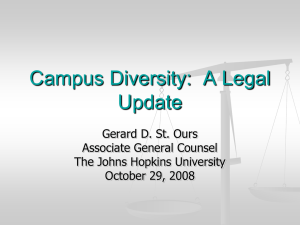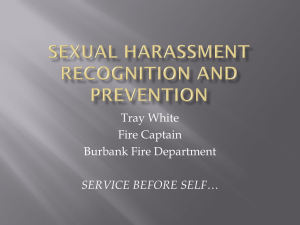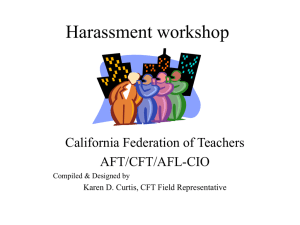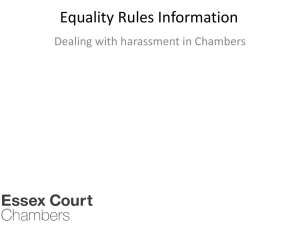Chapter 9
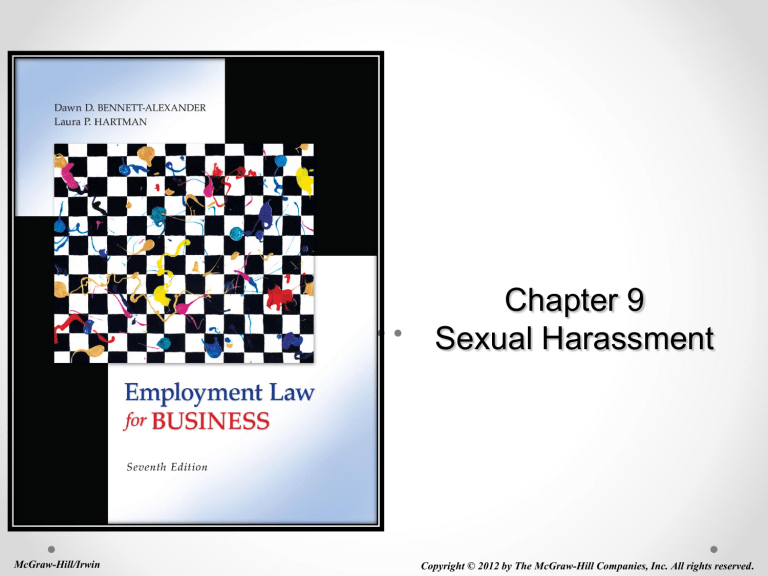
McGraw-Hill/Irwin
Chapter 9
Sexual Harassment
Copyright © 2012 by The McGraw-Hill Companies, Inc. All rights reserved.
Learning Objectives
Discuss the background leading up to sexual harassment as a workplace issue
Explain quid pro quo sexual harassment and give the requirements for making a case
Explain hostile environment sexual harassment and give the requirements for making a case
9-2
Learning Objectives
List and explain employer defenses to sexual harassment claims
Define the reasonable victim standard and how and why it is used in sexual harassment cases
Differentiate the sex requirement and antifemale animus in sexual harassment actions
9-3
Learning Objectives
Explain employer liability for various types of sexual harassment claims
Describe proactive and corrective actions an employer can take to prevent or lessen liability
9-4
Introduction
Sexual harassment in the workplace occurs more frequently than many realize
Sexual harassment class action trials
The “white buffalo”
Cost to businesses
Liability is avoidable through a few simple steps
9-5
Introduction
Anita Hill and Clarence Thomas
Effect on the workplace environment
Increase in complaints after the hearings
First U.S. Supreme Court sexual harassment case heard in 1986
Difficulty in recognizing sexual harassment when it occurs
9-6
Is It a Big Deal?
Study by the U.S. Merit Systems Protection
Board in 1987
42 percent of federal employees have reported sexual harassment
Survey by Working Woman magazine of 160 of the Fortune 500 companies
Nearly 40 percent had received at least one sexual harassment complaint in the previous 12 months
9-7
Is It a Big Deal?
New York Times poll
4 out of every 10 women have experienced sexual harassment
National Law Journal
60 percent of female attorneys have experienced sexual harassment
Parade Magazine poll
70 percent of women serving in the military have been sexually harassed
9-8
Where do Sexual Harassment
Considerations Leave the Employer?
Consensual relationships are not forbidden by the law
Unwelcome activity – imposes terms and conditions that are different for one gender
Sexual harassment policies in the workplace
9-9
Sexual Harassment in General
Quid pro quo sexual harassment : Sexual harassment in which the harasser requests sexual activity from the harassee in exchange for workplace benefits
Hostile environment sexual harassment :
Sexual harassment in which the harasser creates an abusive, offensive, or intimidating environment for the harassee
9-10
Sexual Harassment in General
Most sexual harassment takes place between males and females
Males bring fewer cases due to fear of ridicule
Affinity orientation is not covered under Title VII
Harassment cases can still be brought regardless of the gender of the harasser and harassee
9-11
Comparison between Quid Pro Quo and
Hostile Environment Sexual Harassment
QUID PRO QUO SEXUAL
HARASSMENT
• Workplace benefit promised, given to, or withheld from harasser by harasser
• In exchange for sexual activity by harassee
• Generally accompanied by a paper trail
HOSTILE ENVIRONMENT SEXUAL
HARASSMENT
• Activity by harasser, toward harassee that
• Is unwanted by the harassee
• Is based on harassee’s gender
• Creates for harassee a hostile or abusive work environment
• Unreasonably interferes with harassee’s ability to do his or her job
• Is sufficiently severe and/or pervasive
• Affects a term or condition of harassee’s employment
9-12
Unwelcome Activity
It is the basis of hostile environment sexual harassment actions
Harasser actions can be direct or indirect
Evidence that the activity is unwelcome can also be direct or indirect
Unwelcomeness parameters
9-13
“Love Contracts”
How they work
What is included
What it should do
How it is useful
Is it legally defensible
Is it worth the effort
9-14
Severe and Pervasive Requirement
Severe and/ or pervasive activity : Harassing activity that is more than an occasional act or is so serious that it is the basis for liability
U.S. Supreme court decision
Sexual harassment claims do not require findings of severe psychological harm to be actionable
9-15
Severe and Pervasive Requirement
Factors that determine whether an environment is hostile or abusive:
Frequency of the discriminatory conduct
Its severity
Whether it is physically threatening or humiliating or a mere offensive utterance
Whether it unreasonably interferes with an employee’s work performance
9-16
Perspective Used to Determine
Severity
Reasonable person standard : Viewing the harassing activity from the perspective of a reasonable person in society at large
Reasonable victim standard : Viewing the harassing activity from the perspective of a reasonable person experiencing the harassing activity including gender-specific sociological, cultural, and other factors
9-17
Perspective Used to Determine
Severity
Viewing severity and pervasiveness from different perspectives renders different results
U.S. Supreme Court decision on Oncale v.
Sundowner Offshore Services Inc.
“The objective severity of harassment should be judged from the perspective of a reasonable person in the plaintiff ’s position”
9-18
“Sexual” Requirement Explained
Sexual element need not be present in order to constitute sexual harassment
Anti-female animus : Negative feelings about women and/or their ability to perform jobs or functions, usually manifested by negative language and actions
Harassment by electronic means
9-19
Employer Liability for Sexual
Harassment
Supervisor toward employee (tangible employment action)
Employer is strictly liable
Presence of a paper trail which gives employers a measure of control
Supervisor toward employee (no tangible employment action)
Employer not strictly liable
Also true for constructive discharge
9-20
Employer Liability for Sexual
Harassment
Coworker harassment third-party harassment of employee
The harasser and harassee are on the same level
Harasser is not employed by the employer (e.g. a client)
Employer is liable if the acts of harassment were known yet no corrective action was taken
9-21
Determining the Truth of Allegations
The EEOC’s Policy Guidance on Harassment
Inherent plausibility
Demeanor
Motive to falsify
Corroboration
Past record
Employees should be involved on a “need to know” basis
9-22
Retaliation and Employee Privacy
Harassee’s fear of retaliation
Requests employers to provide relief without informing the harasser
Harasser must be informed to properly handle the issue
EEOC – dramatic increase in reatliation claims
9-23
Corrective Action
Employers must take “immediate and appropriate corrective action”
The remedy should
Stop the harassment
Not be out of proportion to the act
9-24
Damages and Jury Trials
Civil Rights Act of 1991
Employees suing for sexual harassment can
Get up to $300,000 in compensatory or punitive damages
Request for jury trials
EEOC has institutionalized alternative dispute resolution (ADR)
9-25
Tort and Criminal Liability
Tort actions
Assault
Battery
Intentional infliction of emotional distress:
False imprisonment
Intentional interference with contractual relations
9-26
Tort and Criminal Liability
Jury trails
Unlimited compensatory or punitive damages
Basis for criminal prosecution
9-27
Management Tips
Adopt an anti –sexual harassment policy
Take a top-down approach to deterring sexual harassment
Create and disseminate information about an effective reporting mechanism for harassees
Provide employees with training and/or information that helps them to recognize sexual harassment
9-28
Management Tips
Ensure that reported incidents of sexual harassment are taken seriously
Create an environment where sexual harassment is not tolerated
Promptly investigate all sexual harassment claims
Circulate information only on a need-to-know basis
9-29
Management Tips
Keep an eye out for anti-female animus
Make sure the corrective action is commensurate with the policy violation
Work to keep the workplace friendly and open
9-30

